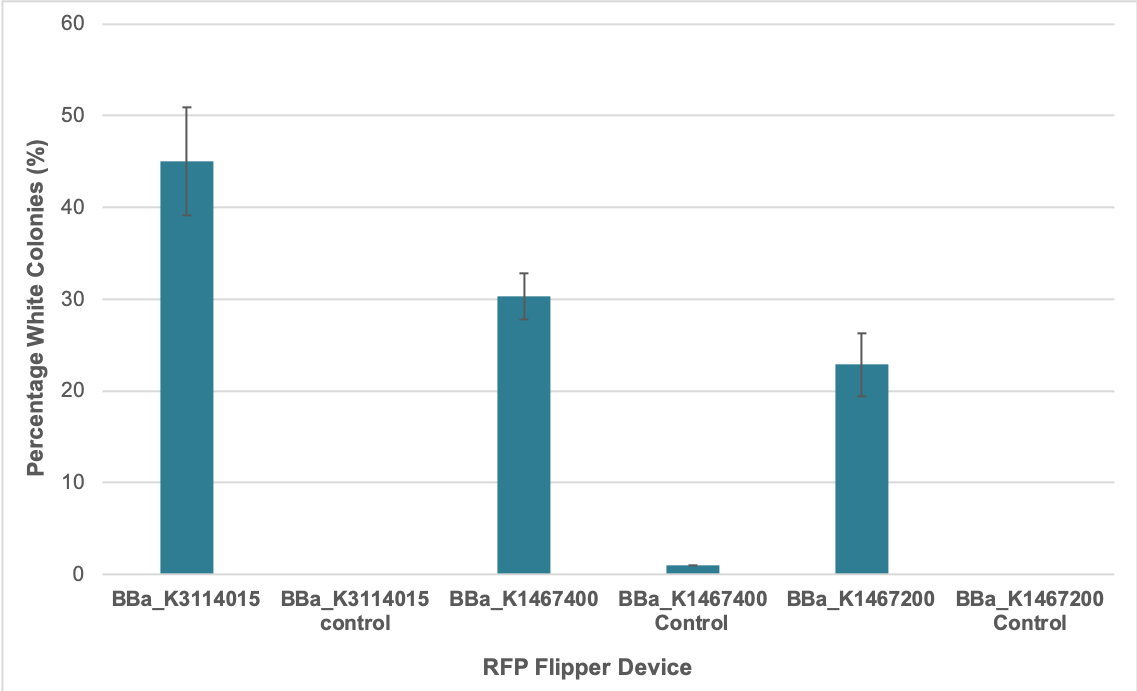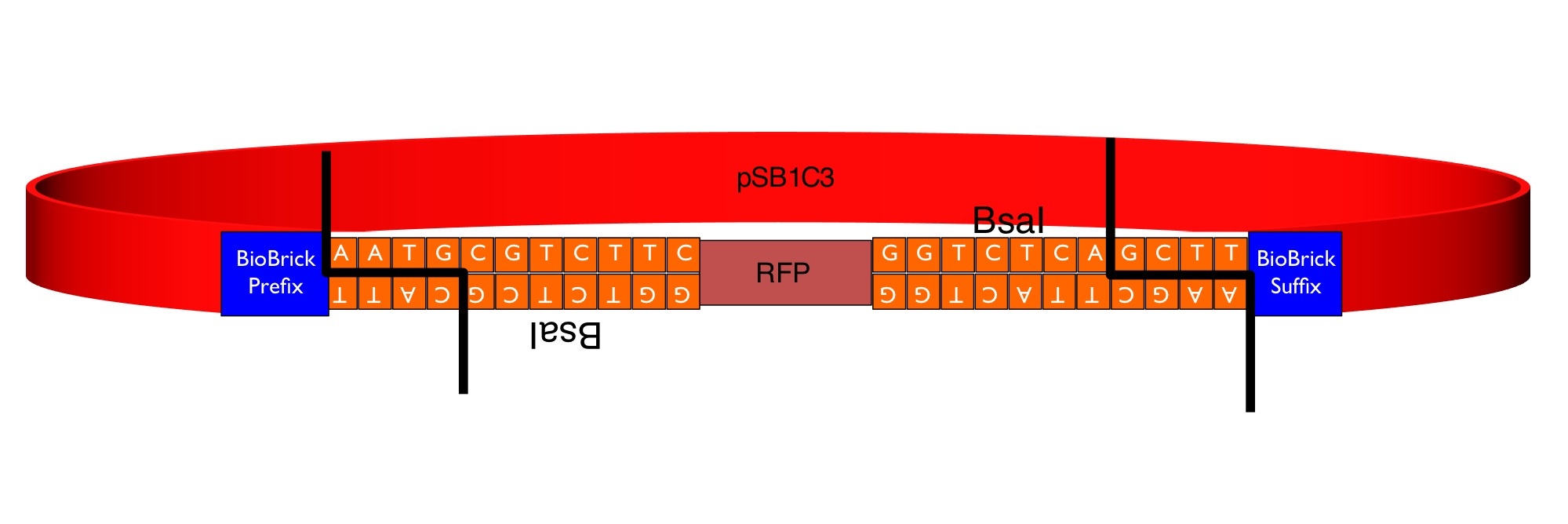Difference between revisions of "Part:BBa K1467200"
(→Contribution - Calgary 2019) |
(→Contribution - Calgary 2019) |
||
| Line 27: | Line 27: | ||
<li>[https://parts.igem.org/Part:BBa_K3114012 BBa_K3114012]</li> | <li>[https://parts.igem.org/Part:BBa_K3114012 BBa_K3114012]</li> | ||
<li>[https://parts.igem.org/Part:BBa_K3114001 BBa_K3114001]</li> | <li>[https://parts.igem.org/Part:BBa_K3114001 BBa_K3114001]</li> | ||
| − | <li>[https://parts.igem.org/Part:BBa_K3114006 BBa_K3114006]</li> <li>[https://parts.igem.org/Part:BBa_K3114013 BBa_K3114015]</li> | + | <li>[https://parts.igem.org/Part:BBa_K3114006 BBa_K3114006]</li> |
| + | <li>[https://parts.igem.org/Part:BBa_K3114013 BBa_K3114015]</li> | ||
</ul> | </ul> | ||
Revision as of 00:19, 21 October 2019
RFP coding device - Golden Gate Module Flipper
This part is a "GoldenGate Flipper" that can be used to convert CDS1 (coding sequence) modules from the GoldenGate MoClo Assembly Standard into standard BioBricks. It consists of the RFP reporter (from BBa_J04450) flanked by an inverted pair of BsaI recognition sequences. GoldenGate MoClo parts can be flipped into BrioBrick parts in a one-pot, one-step, digestion-ligation GoldenGate cloning reaction. The image below shows the sequences inserted (in orange) between the RFP and the BioBrick prefix and suffix that enable the flipper to accept MoClo CDS1 parts, which begin AATG and end GCTT.
The colonies containing the RFP part are clearly red in color under natural light after about 18 hours. Smaller colonies are visibly red under UV. The RFP part does not contain a degradation tag and the RBS is strong. When the flipper reaction is successful the colonies become white as the RFP sequence is replaced by the new part. No part of the BsaI recognition sequence will remain between the BioBrick suffix and the new part.
iGEM14_NRP-UEA-Norwich have used this part to convert GoldenGate "CDS" (coding sequence) modules from the GoldenGate MoClo Assembly Standard into standard BioBricks. The cloning reaction was a Golden Gate one-step, one-pot reaction where the restriction enzyme, ligase and (intact, uncut) donating and recipient plasmids were all incubated together in a single reaction before transformation into competent E.coli cells. Cloning was very successful as the vast majority of the colonies are white as the RFP sequence was replaced by the new part.
Contribution - Calgary 2019
Group: [http://2019.igem.org/Team:Calgary iGEM Calgary 2019]
Author: Sravya Kakumanu, Sara Far, Nimaya De Silva, Cassandra Sillner
Summary: We measured the Golden Gate assembly efficency when using this part (BBa_K1467200), BBa_K1467400, and our improved part BBa_K3114015 in the destination vector.
Documentation:
We determined the average percent successful assembly for this part (BBa_K1467200), BBa_K3114015, and BBa_K1467400 based on the proportion of white colonies following transformation of Golden Gate assembly samples. Colonies will only become white in appearance (rather than red) if the insert DNA has replaced the RFP coding device between the BsaI sites, and has been assembled in the correct order to allow for successful ligation.
Golden Gate assembly reactions were set up to each contain the same amount of destination vector and required DNA inserts in the form of PCR products. A 1:1 insert:destination vector ratio was used in each reaction. They were conducted as per our Golden Gate assembly protocol. As per the overhang/fusion site sequences associated with the BsaI restriction sites in BBa_K3114015 and BBa_K1467400, they were used in four-insert assembly reactions using parts:
The other RFP Golden Gate flipper (BBa_K1467200) features overhang/fusion site sequences associated with the BsaI restriction sites that necessitated two-insert assembly reactions using parts:
The Golden Gate assembly products were transformed into E. coli DH5-alpha. Some colonies became visibly red under normal light after 12 hours for BBa_K3114015, and after 18 hours for BBa_K1467200 and BBa_K1467400. We counted the number of red versus white colonies 24 hours after transsformation for each of the replicates. The results suggest that the two-insert Golden Gate assembly reactions had slighly lower efficiency compared to the four-insert reactions for the closely-related BBa_K1467400 part. Further analysis is required to determine whether this is caused by the differences in the flipper device designs or due to sequence elements within the DNA inserts that we used for these experiments. The improved flipper BBa_K3114015 showed higher efficency than both BBa_K1467400 and BBa_K1467200.

Sequence and Features
- 10COMPATIBLE WITH RFC[10]
- 12COMPATIBLE WITH RFC[12]
- 21COMPATIBLE WITH RFC[21]
- 23COMPATIBLE WITH RFC[23]
- 25INCOMPATIBLE WITH RFC[25]Illegal AgeI site found at 793
Illegal AgeI site found at 905 - 1000INCOMPATIBLE WITH RFC[1000]Illegal BsaI site found at 1082
Illegal BsaI.rc site found at 6


